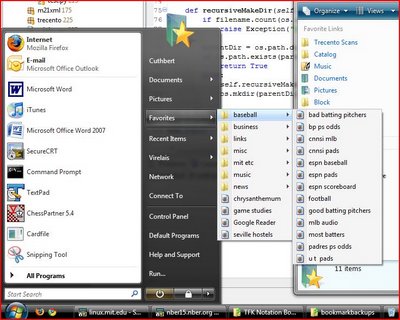The most important stat for determining the quality a pitcher (at least over the course of a career) is ERA. There's really no argument that can be made against it. Wins are far too dependent on how the rest of the team (i.e., batters) do; strikeouts certainly show domination, and career strikeout numbers show longevity as well. But in terms of doing his job, preventing runs, career ERA is the single number that shows how well this was accomplished. (Okay, perhaps ERA over a 5-10 year peak period might be better, to not diminish the careers of those who choose to keep playing into their "worse than average but far better than replacement" years). The main problems with ERA are that it does not adjust for ballparks, leagues, mound heights, steroid usage of batters, or other factors that changed over the years.
Fortunately, the concept of adjusted ERA takes care of all this. And adjusted ERA+ makes reading adjusted ERA even easier. An aERA+ of 125 roughly means an ERA 25% lower than the league, adjusting for park effects etc. (okay, actually it's 20% lower; since an aERA+ of 200 means an ERA 50% of that of the league). An aERA+ of 125 also means you're likely to need to prepare a speech for Cooperstown. The vast majority of pitchers above 125 and almost all eligible starters above 130 are in the Hall.
For a long time, there was a big gap between aERA+ #1 and #2, with Pedro Martinez's 160 towering over Lefty Grove's 148. This disappointing season has lowered Pedro to a mere 157, but it would take more than a few years of (relative) mediocrity to drop him below Grove or Walter Johnson. (Next on the list, for those curious, is Dan Quisenberry which is probably the best Hall of Fame case for Quisenberry that could ever be made).
But why bring all this up now? Because despite Martinez's struggles, there's now (as of last week) a much bigger gap between #1 and #2:
1. Mariano Rivera 197
2. Pedro Martinez 157
What happened? Rivera pitched his 1000th inning last week, making him eligible for career ERA awards. Perhaps the IP requirement should be raised so that the list isn't dominated by closers. But maybe that's not necessary. With the development of the minor-league (or even high school) relief specialist, fewer and fewer will reach this plateau with each passing year. Bochy and Bud Black's cautious use of Trevor Hoffman since he returned from surgery six years ago has kept him from breaking the 1000 IP mark. As of this evening, he's 22 IP short. Since he's been averaging .35 IP per game over the past four seasons, he's likely to end the season (and possibly his career? the fan in me hopes not) about five innings short. His aERA+ of 145 would place him 9th or 10th all time. Prior to this disastrous season, he would have been third.
(For the complete list, see
Baseball-Reference.com)
The only other reliever on the ERA title horizon is Billy Wagner, whose aERA+ of 180 would place him comfortably in second, though still at a great distance below Rivera. However with only 819 IP, he will likely need three more seasons to qualify. And anything could happen by then. Troy Percival, with an aERA+ of 151 but only 687 IP, averaging fewer than 50IP/year at age 38, seems highly unlikely to qualify.
Of the other active high saves players, Roberto Hernandez already qualifies at 131; a Hall of Fame number for a starter, but unlikely to get a notice for a reliever with "only" 326 saves. Jose Mesa is what we always thought him to be, exactly an average pitcher (aERA+ of 100), and thus probably a below average reliever. Todd Jones is a little better, but nothing to write to Cooperstown about. Ditto Jason Isringhausen, 100IP short; though kudos to him for having such dreadful recent performances that his manager is bringing back the (great) idea of a closer by committee.
And as far as the brilliant young closers of today. Yes, very exciting. Yes, I know Papelbon has an aERA+ of 269(!); K-Rod at 186; Nathan at 152; Lidge at 147. But for an article on a stat that requires 1000 IP, please ring again when there's just a few hundred innings left to go. Why so pessimistic? Robb Nen, John Wettland, Randy Meyers, Tom Henke, Jeff Montgomery, Rod Beck, Ugueth Urbina, and (ah heck, throw in the newest member of the fraternity) Eric Gagne. If these names mean something to you, you'll understand.
 (Not sure if the right hand part matches the actual guitar parts used in the piece, but they're close enough for illustrative purposes).
(Not sure if the right hand part matches the actual guitar parts used in the piece, but they're close enough for illustrative purposes).

